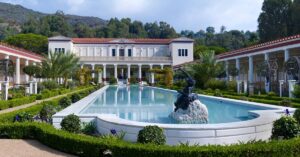China has a history longer than that of any other present day nation. We have plenty of myths and legends. These ancient stories have been passed down through centuries, and these myths offer profound insights into how the Chinese people have perceived their world and their place in it over millennia.
The universe’s originator and first living entity, Pangu, personifies the primordial forces that fashioned the planet. His story of the separation of heaven and earth represents the creation of order out of chaos. The goddess Nüwa, who fashioned humans and fixed the sky, stands for the protective and healing powers of the natural world.
The Three Sovereigns, Fu Xi, Shen Nong, and Huangdi, are revered as cultural heroes for their pivotal role in introducing key elements of civilization. The Five Emperors, who succeeded the Three Sovereigns, are credited with furthering the development of Chinese society through advancements in culture, agriculture, and government.
Pangu
The first figure in our history is Pangu, regarded as the Chinese Adam by westerners.
Also Read
According to legend, in the beginning, there was only darkness and chaos. Then, an extremely large egg appeared. This vast egg was subjected to two opposing forces or principles. The interaction of the two forces- yin, the passive or negative female principle, and yang, the active or positive male principle- caused the egg to produce Pangu and the shell to separate. The upper half of the shell formed the heaven, and the lower half the earth.
Pangu has been depicted in many ways. He sometimes appears as a dwarf with two horns on his head, clothed in skin or leaves. He may be holding a hammer in one hand and a chisel in the other, or perhaps the symbol of yin and yang. He may also be shown holding the sun in one hand and the moon in the other. He is often depicted with his companions, the four supernatural animals – the phoenix, the dragon, the unicorn, and the tortoise.
In any case, Pangu grew rapidly and increased his height by six to ten feet daily. He hammered and chiseled a massive piece of granite floating aimlessly in space, and as he worked, the heavens and the earth became progressively wider. He labored ceaselessly for eighteen thousand years, and finally, he separated heaven from earth. His body dissolved when his work was done.
Following his death, his head became the mountains, his breath the wind and clouds, his voice the thunder; his left eye became the sun, and his right eye the moon. His beard became the stars, his four limbs the four quadrants of the globe, his blood the rivers, and his veins and muscles the layers of the earth. His flesh became the soil, his skin and hair became the trees and plants, his seminal fluid became pearls, and his marrow precious stones. His sweat turned into rain, and the parasites on his body, impregnated by the wind, began the human race.
Through his great labor, Pangu divided chaos into yin, represented by the Royal Mother of the West, and yang, represented by the Duke of the East. These two principles gave birth to the Heavenly Emperors, who were followed by the Earthly Emperors, the ancestors of the Chinese rulers. The important ones were three Sovereigns and five emperors.

Nüwa: Makes Men and Mends the Sky
It is said that there were no men when the sky and the earth were separated. It was Nuwa who made men by molding yellow clay. The work was so taxing that her strength was not equal to it. So she dipped a rope into the mud and then lifted it. The mud that dripped from the rope also became men. Those made by molding yellow clay were rich and noble, while those made by lifting the rope were poor and low.
In a ancient times, the four corners of the sky collapsed and the world with its nine regions split open. The sky could not cover all the things under it, nor could the earth carry all the things on it. A great fire raged and would not die out; a fierce flood raced about and could not be checked. Savage beasts devoured innocent people; vicious birds preyed on the weak and old.
Then Nuwa melted rocks of five colors and used them to mend the cracks in the sky. She supported the four corners of the sky with the legs she had cut off from a giant turtle. She killed the black dragon to save the people of Jizhou and blocked the flood with the ashes of reeds.

Thus the sky was mended, its four corners lifted, the flood tamed, Jizhou pacified, and harmful birds and beasts killed, and the innocent people were able to live on the square earth under the dome of the sky. It was a time when birds, beasts, insects and snakes no longer used their claws or teeth or poisonous stings, for they did not want to catch or eat weaker things.
Nuwa’s deeds benefited the heavens above and the earth below. Her name was remembered by later generations, and her light shone on every creation. Now she was traveling on a thunder-chariot drawn by a two-winged dragon and two green hornless dragons, with auspicious objects in her hands and a special mattress underneath, surrounded by golden clouds, a white dragon leading the way, and a flying snake following behind. Floating freely over the clouds, she took ghosts and gods to the ninth heaven and had an audience with the Heavenly Emperor at Lin Men, where she rested in peace and dignity under the emperor. She never boasted of her achievements, nor did she try to win any renown; she wanted to conceal her virtues in line with the ways of the universe.
The Three Sovereigns
The Three Sovereigns (三皇, Sān Huáng) were Fu Xi, Shen Nong, Huang Di.
Fu Xi (伏羲)

Fu Xi was born in the Shaanxi Province and, according to legend, was carried in his mother’s womb for twelve years before birth. He taught people how to hunt, fish, domesticate animals, and tend their flocks. He instituted marriage and taught people how to devise tools to split wood, kindle fire, and cook food. He devised the mysterious Trigrams, which evolved from markings on tortoise shells. These trigrams served as the basis for mathematics, medicine, divination, and geomancy and as clues to the secrets of creation, such as the evolution of nature and its cyclic changes. He was considered as the first real ruler.
Fu Xi was succeeded by a person named Nv Wa, who was his own sister, according to the legends. She did not add much work based on Fu Xi’s in the new way of civilization. But it was she who achieved in heaven patching. When Fu Xi’s evil spirit, his minister Gong Gong, smashed the vault of heaven, Nv Wa patched it up by melting stone.
Shen Nong (神农)
Shen Nong, the Divine Farmer, followed Fu Xi and reigned after him. According to legend, Shen Nong was conceived through the influence of the Heavenly Dragon. He is credited with inventing the wooden plow and teaching people the art of agriculture. By experimenting with various plants, he discovered which plants were useful and which plants were harmful or poisonous. He was deeply absorbed in the study of herbs in order to find remedies for diseases among his people. He was very successful in his investigations.
He was regarded as “The Prince of Cereals” by the farmers, and his classic of Shen Nong’s Botany (Shen Nong Ben Cao Jing ) is still in use. He also expanded the system of eight trigrams into sixty-four hexagrams.
Huang Di (黄帝)

Huang Di was the most famous tribe chieftain in ancient China and was considered the ancestor of the Chinese nation. He is said to have had full command of the language while still an infant.
Huang Di invented the wheel and discovered the art of making pottery. He improved communication by building roads, bridges and ships. He divided time into sixty-year cycles.
He led an army to fight Chiyou, the leader of barbarian tribes, in Zhuolu in modern Hebei Province. He captured and slew him. With the overthrow of Chiyou, he was elected to the powerful chieftain. He had wise ministers to help him with the reforms. He instructed them to build houses for his people, to compose a calendar for farming, and to make musical and astronomical instruments. He invented carts drawn by oxen. The rivers and lakes in his time were soon covered with barges. His army soldiers used bows, arrows, and swords provided by him. Under his administration, precious stones, gold, and copper were introduced to serve as money. His consort, Lady Xi Ling, is credited with developing the art of sericulture- the raising of silkworms and the methods of silk production. She also taught people the art of weaving.
Huang Di governed for about one hundred years. He died after a glorious reign.
The Five Emperors
The Five Emperors (五帝, Wǔ Dì) are legendary rulers and cultural heroes in ancient Chinese mythology.
The five Perfect Earthly Emperors in the Chinese legendary period were Shaohao, Zhuanxu, Gaoxin, Yao, and Shun.
Shaohao (少昊)
Shaohao was the renowned leader among the Yi people in East China. It was said that their origins were birds after which the tribe officials were named. Birds were highly respected and taken as totem. They had officials responsible for both industry and agriculture. They were active in southern Shandong and later expanded to eastern Henan.
Zhuanxu (顓頊)
Zhuanxu, also Gao Yangshi, was active in the present-day Henan. He was said to be extremely wise and intelligent. He respected gods and taught his people. He appointed a special official as “Nanzheng” responsible for offering sacrifices to gods in the heaven, and another official as “Huozheng” in charge of the civil affairs.
Gaoxin (高辛)
Gaoxin, also Ku, was said to be a descendant of Huangdi. He was different from common people by birth. He could tell his name when he was born. He possessed both a macro knowledge of things and micro knowledge as well. People benefited from him and they were obedient to his administration. He enjoyed a high prestige among his tribal people.
Yao (堯)

Yao, who was born with eyebrows of eight different colors, is said to have reigned beginning in 2356 BC. Under his direction, his court astronomers determined the dates of the solstice and equinox, added days and months to adjust the lunar calendar, and fixed the four seasons so that farmers might know when to plant and harvest crops.
After ruling for seventy years, he relinquished his throne and selected Shun, instead of his own son, to be the next emperor. He also married his two daughters, Nu Ying and Huang, to Shun.
Shun (舜)
Shun, a native of Henan Province, was unusually gifted physically and mentally. He is described as having two pupils in each eye.
Shun was disliked intensely by his father, stepmother, and stepbrother, who tried to kill him on two occasions. Once, while Shun was working on a roof, they removed the ladder and set the house on fire. Later, when he was working in a well, they attempted to bury him alive. Both times, he managed to escape unharmed. Despite their attempts on his life, Shun always demonstrated extreme devotion and filial piety toward his father and stepmother. It was because of this virtue, as well as others that Yao selected Shun as his successor. Shun’s reign extended to 2255 BC.






